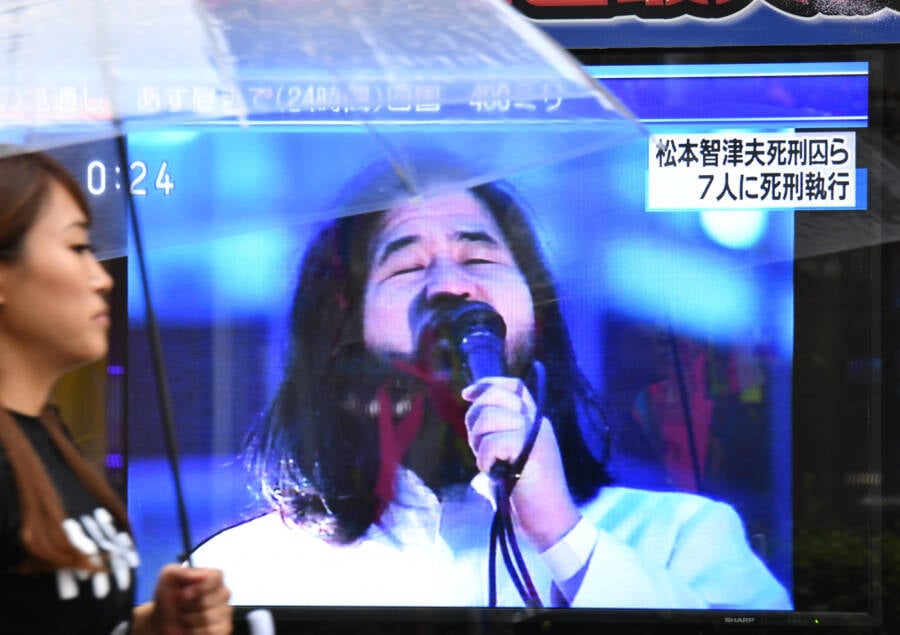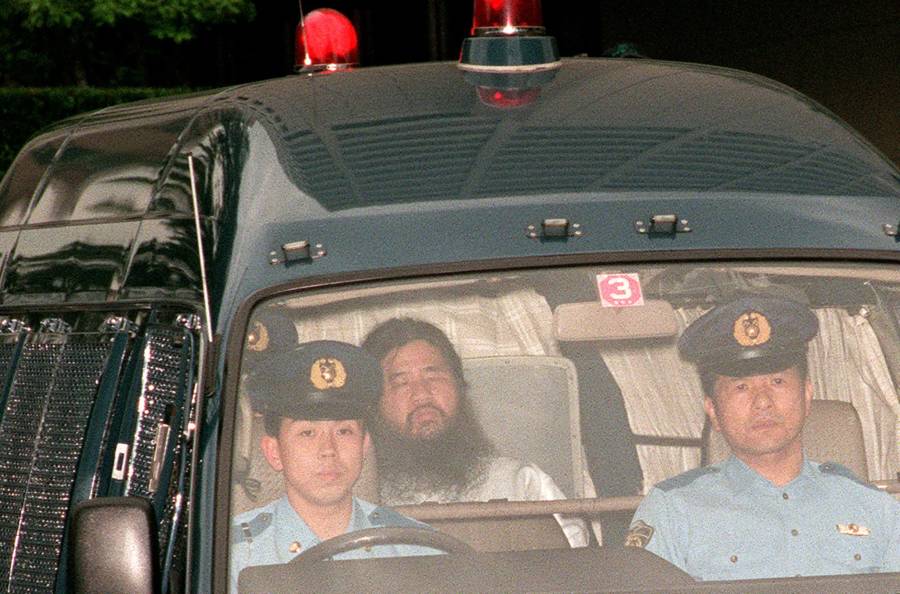Aum Shinrikyo was founded in 1980s Japan as a yoga and meditation group, but before long, leader Shoko Asahara pushed the group toward chemical weapons manufacturing and terrorist attacks.

Wojtek Laski/Getty ImagesShoko Asahara, leader of the cult group Aum Shinrikyo, during a visit to Moscow on February 17, 1994.
In 1984, Chizuo Matsumoto founded the Japanese group Aum Shinrikyo as a simple yoga class. The group’s practices drew upon Matsumoto’s idiosyncratic views on Buddhism and Hinduism while incorporating Christian philosophies and the writings of Nostradamus.
Then, Matsumoto changed his name to Shoko Asahara, published a book on his teachings, and began to refer to himself as “Tokyo’s Christ.” Telling his followers that he was the only enlightened master in Japan and claiming that he could take away their sins, he began declaring to his followers that the end times were near.
In 1995, the group carried out a devastating sarin gas attack on a Tokyo subway and made a name for itself as one of the world’s most frightening doomsday cults.
Shoko Asahara And The Start Of Aum Shinrikyo

Natsuki Sakai/AFLO/Alamy Live NewsA news report on July 6, 2018 about the execution of cult leader Shoko Asahara and six of his followers.
The man who turned a yoga class into a murderous organization came from humble beginnings.
Shoko Asahara, born Chizuo Matsumoto, according to The New York Times, grew up in a poor family of tatami mat makers. As a child, he lost part of his sight to infantile glaucoma and was sent to a school for blind students.
On his graduation, he left his classmates with few nice things to say about him. Peers remember him as a bully who wanted money and had few scruples about how he obtained it.
After leaving school, he began selling herbal remedies, a career that proved inadequate to support his wife and growing family. He eventually strayed into more questionable business practices and, in 1982, was found guilty of practicing pharmacology without a license.
That’s when things took a turn toward the mystical.
Asahara became deeply interested in meditation and ancient religious philosophy. He mixed Hindu, Buddhist, and Christian teachings with Nostradamus’s prophecies and began promulgating his beliefs in the yoga and meditation sessions he taught.
What started in 1984 as a yoga school became, in 1987, the group Aum Shinrikyo, which, according to Encyclopedia Britannica, gained official recognition as a religious organization in Japan just two years later.
In books and frequent appearances on talk shows, Asahara promised members health and a better life through spirituality, focus, and positive thinking — a message that garnered him an increasingly enthusiastic following.
Asahara Makes Followers New Promises — And Threats

Wikimedia CommonsHorrified parents began to campaign against Aum Shinrikyo, claiming that the cult was brainwashing their children. Some continue to protest the group’s remaining offshoots to this day.
As time went on, Asahara’s claims grew bolder. He began to refer to himself as the “Holy Pope,” “Saviour of the Country,” and “Tokyo’s Christ.” He offered salvation and promised to take on the world’s sins while sharing his spiritual power and wisdom with followers.
The group was insular, and many of its members lost contact with their families either intentionally or as a result of their activities.
His teachings also found a surprising foothold in the country among young academics and college students, who felt the cult’s ideas were progressive and a relief after years of high-pressure academic competition.
“There are many sophisticated people among the members,” said Yoshiro Ito, a lawyer representing some families trying to get children back from the group in 1995. “They come from elite families.”
Many aspects of cult life were shrouded in secrecy, but some who escaped the cult report undergoing shock therapy and taking hallucinogenic drugs.
One man, said to have been brought to the cult by his daughters, escaped after weeks of being forced to drink gallons of hot water a day and throw it up to “purge his system,” according to the New York Times.
Rumors began to circulate. An anti-cult lawyer causing Aum Shinrikyo trouble abruptly disappeared with his family and was never seen alive again. Some whispered that people who wanted to leave the group were being held against their will and forced to sign over substantial sums of money.
Others were seemingly killed when they announced their intention to withdraw from the cult.
But Aum Shinrikyo continued to grow. By the early 1990s, the group had amassed some 10,000 members in Japan and several thousand around the world, notably in Russia.
Enter The Apocalypse: Aum Shinrikyo Becomes A Doomsday Cult

United States Public Health Service/Wikimedia CommonsAn overhead view of Satyan 7, the Aum Shinrikyo chemical plant.
The deadliest aspect of Asahara’s philosophy was his conviction that the apocalypse was near at hand. The guru believed that only initiates of Aum Shrinrikyo would survive the end of the world — and to hasten a future where only the devout inhabited the earth, they sought to bring it about themselves.
In 1990, the cult tried to gain a foothold in Japanese politics, hoping to wield influence in the government, but after all of their 25 candidates for parliament failed, they abandoned the scheme.
At this point, Japanese authorities officially branded Aum Shinrikyo a cult.
After they failed in the political sphere, group members turned their efforts inward, amassing guns, working on biological weapons, and acquiring vast quantities of the Nazi-era nerve gas known as sarin.
The plant wasn’t the group’s first attempt to poison the city. In 1993, they sprayed an anthrax-infected liquid from the roof of their building in Tokyo; people in the area reported a pervasive nasty stench, but nobody contracted anthrax or was otherwise injured.
Undaunted, they struck again the following year. Initial experiments with sarin gas had proved successful, so they targeted a neighborhood home to several judges expected to rule against the cult in a land dispute.
Eight died and 500 were injured, but the judges all survived. The cult was never suspected.
The Devastating Tokyo Attack

United States Public Health Service/Wikimedia CommonsEmergency personnel respond to the Tokyo subway attack on March 20, 1995.
Since no one knew the group was manufacturing deadly chemicals, Asahara and his followers largely escaped detection.
That is, until March 20, 1995, when members of the group, carrying concealed bags of sarin gas, boarded five separate subway trains headed for central Tokyo.
The cult members punctured the bags with the tips of their umbrellas and walked off the train.
Inside the subway, the odorless, colorless gas spread throughout the cars and stations. In many instances, liquid particles condensing on the clothes of those affected would in turn expose those trying to help them, compounding the spread.
The attack killed 13 people and injured 5,500. Many of the injured still deal with the aftereffects to this day.
At last, police eyes turned to the cult. In the days following the attack, police raided the group’s compounds, discovering malnourished and dehydrated followers — and massive amounts of additional chemicals.
On May 16, authorities arrested Shoko Asahara. A judge handed down a death sentence that Asahara would spend years unsuccessfully appealing.
He was finally hanged on July 6, 2018, with six other cult members executed the same week.

AFP/Getty ImagesA child of a member of the secretive sect Aum Shinrikyo is taken from a facility by police.
Despite The Horrors Of The Past, Aum Shinrikyo Lives On
In the years since the Tokyo attack, former Aum Shinrikyo followers have spoken out about their experiences and written books about life inside the cult. Asahara dealt with disobedience harshly, torturing and sometimes killing those who failed to follow the party line.
The cult also resorted to kidnapping to influence its members. Anyone who tried to leave the group faced torture or death.
Though the group’s membership has waned under public pressure, infighting, and government crackdowns, it still survives — albeit with a new name. In 2000, the group rechristened itself “Aleph.” Aleph further splintered in 2007, giving birth to another Aum Shinrikyo offshoot, Hikari no Wa, or “Ring of Light.”

JIJI PRESS/AFP/Getty ImagesIn this picture taken on July 19, 1995, Shoko Asahara is transferred from Tokyo police headquarters to Tokyo District Court for questioning.
Somehow, Aleph and Hikari no Wa still have members today. Many are in Eastern Europe and Russia, where Aum Shinrikyo’s former followers joined the new groups. Though Asahara is gone, his philosophy lives on — and the world keeps a wary eye on its disciples.
After learning about Aum Shinrikyo, check out these five insane cults from around the world that are still active today. Then, read about the cult of Rajneesh, the group that carried out the largest bioterror attack in American history.





